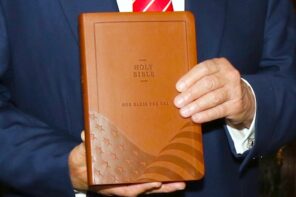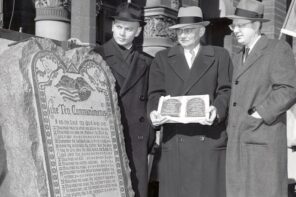It looks like Terry Jones, the radical extremist who achieved world renown for burning the sacred scripture of another religion, may be returning to the limelight. Although many would like to forget or ignore the fanatical activities of this marginal pastor, Jones, the leader of a small congregation in northern Florida, plans to raise a ruckus in protest against Islam in Dearborn, Michigan—a city with one of the largest populations of Muslims in the nation.
His picture is starting to pop up everywhere, and if he follows through on his plans, the media will certainly go with the kind of full-throttle coverage reserved for the crème de la crème of reality celebrityhood—failed “American Idol” contestants, or breakout stars from “The Real Housewives of…,” or the latest YouTube sensation. The hundreds of articles and blogs lined up on Google News will likely grow in the week ahead, thanks in part to events that have begun to unfold in Dearborn—including Jones almost shooting himself in the foot in the parking lot of a local TV station, and his outraged response to a court order prohibiting his planned protest. It will get ugly, no doubt.
Egghead scholars and interfaith leaders, bloggers on both sides of the political aisle, and everyday Americans will surely condemn him for his outrageous actions and beliefs, and argue that Jones is an isolated, peripheral figure whose religious views are borderline paranoid delusional, if not well past that line. Are Jones’ actions motivated by authentic religion or dysfunctional psychology? Genuine fear about the threat of another religion or an idiosyncratic psychotic vision distorting religious theology in the throes of irrational hatred?
While the Wall Street Journal published a recent article that casually identifies Jones as a “Christian pastor,” and other outlets use less tame designators like “radical preacher” or “Koran-burning preacher,” the exact location of Jones within the Christian fold is difficult to pinpoint. Some place him beyond the bounds of Christian theology while others put him smack dab in the middle of engaged Christian fundamentalist activism. Yet regardless of the public disagreements over the rights and values of Preacher Jones, one thing is crystal clear: He represents a dying breed in American society and that, I think, is another if not the critical factor in understanding both his actions and his symbolic presence in the media.
White, male, heterosexual, conservative Christians (WMHCC from here on out) are losing their numbers in American society and could, if some projections hold true, diminish to a small minority in the next 20 years; part of a larger trend that one influential study has labeled the “vanishing Protestant majority.” In a recent analysis by the Public Religion Research Institute based on post-2010 election surveys, the number of white Protestants in America is projected to decline dramatically in the next fifty years. This is one of the most significant demographic shifts in American history.
One can easily see how this might lead to more individuals like Jones entering the culture wars to battle against the perceived moral and mortal threats destroying their peculiar vision of Christian America.
The real stakes in this battle are about sheer survival for these men, and their sense of vulnerability, disintegration, and impotence when facing the radical social changes taking place in 21st-century America. Fear of increasing religious diversity, shifting sexual values, and diminishing economic opportunities is transformed into and then projected out as a moral worldview that embraces bigotry, intolerance, and a commitment to violence when necessary.
It is an absolutist Christian theological outlook that leads mere mortals to believe they understand God’s will and that any who disagree are not simply wrong, but an enemy of God.
On the one hand, this moral universe has been a driving force in US history and an all-too-familiar disposition to value hatred, as I’ve written about before. But on the other hand, and what’s so new and rife with hateful and violent possibilities, is that at this moment in US history WMHCC increasingly perceive their hold on power to be imperiled by social and demographic forces beyond their control.
The picture is indeed grim for this group, what with growing numbers of Americans preferring to identify with no religion; religious pluralism bringing more and more Hindus, Buddhists, Jains, Mormons, Jews, New Agers, Muslims, and a slew of others all around them; the younger evangelical generations showing signs of greater openness to non-heterosexual orientations; myriad versions of Christianity in immigrant communities that are unfamiliar if not downright blasphemous; and a popular culture riddled with hip hop artists, filmmakers, cable comedy variety news shows, and television producers willing to openly mock and demean that moral universe.
But even more radically distressing is the prospect of losing the cultural—dare I say hegemonic—power over American society that is as old as the republic. Is it that outrageous to claim WMHCC have generally been the primary power brokers (in government, in law, in finance, in churches) determining the course and self-definition of the nation? A few Jews here, a smattering of progressives there, and some people of color, to be sure; but if you take the long view of US history, it’s mostly WMHCC who’ve been in charge. This is certainly congruent with recent ruminations about the “triumphant decline of the WASP” most recently identified with the striking absence of white Protestants on the Supreme Court.
While it is true that a quick glance at the US Congress seems to contradict this view, the election of the first non-white president has been fraught with portentous and perilous meanings for WMHCC—to a degree that far exceeds the hysteria ignited when the first and only liberal Catholic was elected president a half century ago. What could be more telling about shifting power structures than the dynamics of the 2008 presidential elections, the selection of the symbolic head of the body politic?
And it is certainly the case that the Republican Party has been taken over by a predominantly white, religiously conservative, and aggressively nationalistic Tea Party hoping to snuff out any signs of political muscle by moderates. But rather than provide succor and reassurance for WMHCC, the Tea Party has its own agenda—willing to sell out their souls to big money, fixate on the national debt while the rest of society falls apart, and emasculate America’s moral power by cutting services and support for the middle class and poor. When survival is the name of the game, how will WMHCC rally the diminishing troops in a desperate bid to hold on to the power slipping from their hands?
Is Terry Jones merely on the fringes of US Protestantism or is he at the vanguard of a new cultural movement taking shape in the tattered, crumbling fragments of a once-dominant presence in the centers of power? When I look into his dull, vacant eyes I certainly see fear, but it’s not a fear of a false Abrahamic faith, or a fear of cultural differences, or a fear of growing religious diversity so much as it’s a fear of the future and an awareness of increasing powerlessness.
Personally, as an American citizen who values religious freedom and appreciates difference, I would like to ignore the reappearance of Jones on the media horizon. But as a historian of American religious cultures I’m shaking in my boots about Jones and others on the fringes who could very well creep in and radically, if not violently, alter America’s future.




